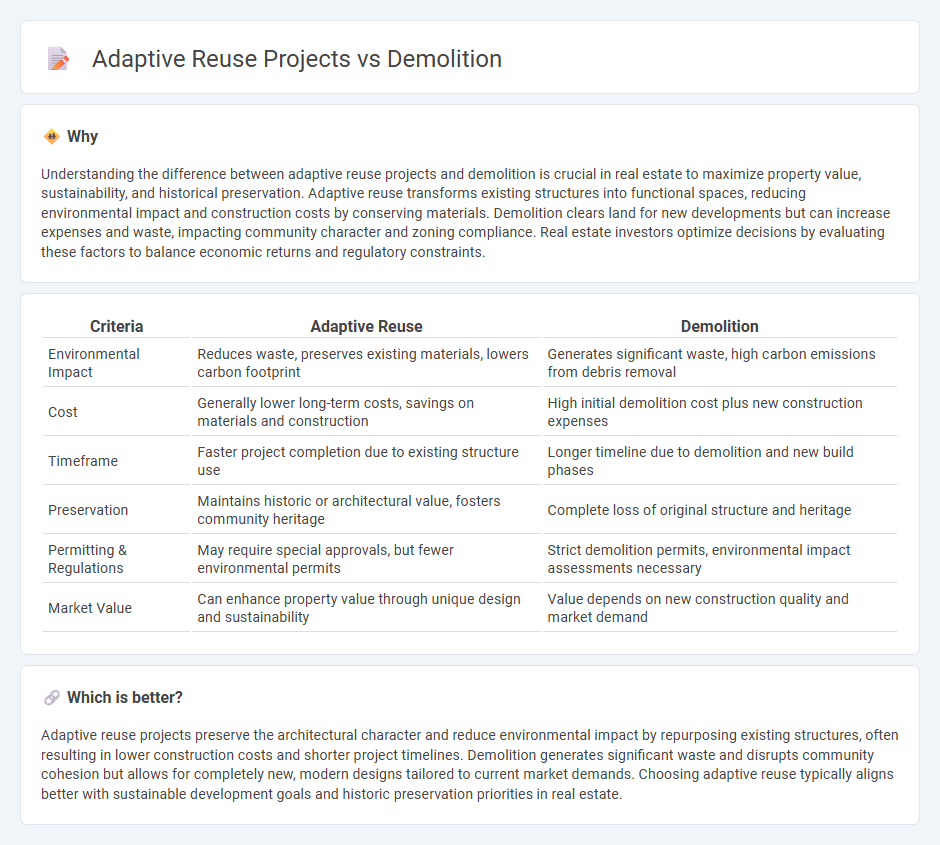
Adaptive reuse projects transform existing structures into functional spaces while preserving architectural heritage, reducing environmental impact, and often lowering construction costs compared to demolition and new builds. Demolition clears the site for fresh development but generates significant waste and higher resource consumption. Discover how adaptive reuse can maximize real estate value and sustainability in your next project.
Why it is important
Understanding the difference between adaptive reuse projects and demolition is crucial in real estate to maximize property value, sustainability, and historical preservation. Adaptive reuse transforms existing structures into functional spaces, reducing environmental impact and construction costs by conserving materials. Demolition clears land for new developments but can increase expenses and waste, impacting community character and zoning compliance. Real estate investors optimize decisions by evaluating these factors to balance economic returns and regulatory constraints.
Comparison Table
| Criteria | Adaptive Reuse | Demolition |
|---|---|---|
| Environmental Impact | Reduces waste, preserves existing materials, lowers carbon footprint | Generates significant waste, high carbon emissions from debris removal |
| Cost | Generally lower long-term costs, savings on materials and construction | High initial demolition cost plus new construction expenses |
| Timeframe | Faster project completion due to existing structure use | Longer timeline due to demolition and new build phases |
| Preservation | Maintains historic or architectural value, fosters community heritage | Complete loss of original structure and heritage |
| Permitting & Regulations | May require special approvals, but fewer environmental permits | Strict demolition permits, environmental impact assessments necessary |
| Market Value | Can enhance property value through unique design and sustainability | Value depends on new construction quality and market demand |
Which is better?
Adaptive reuse projects preserve the architectural character and reduce environmental impact by repurposing existing structures, often resulting in lower construction costs and shorter project timelines. Demolition generates significant waste and disrupts community cohesion but allows for completely new, modern designs tailored to current market demands. Choosing adaptive reuse typically aligns better with sustainable development goals and historic preservation priorities in real estate.
Connection
Adaptive reuse projects transform existing buildings into new functional spaces, offering a sustainable alternative to demolition by preserving structural elements and reducing waste. Demolition is often considered when buildings are structurally unsound or unsuitable for repurposing, but it generates significant construction debris and environmental impact. The decision between adaptive reuse and demolition hinges on factors like economic feasibility, historical value, and regulatory requirements within the real estate development process.
Key Terms
Zoning Regulations
Demolition projects often face strict zoning regulations that dictate allowable building heights, setbacks, and land use, potentially increasing costs and approval times. Adaptive reuse projects must comply with zoning codes while preserving existing structures, which can offer incentives like tax credits and flexibility in mixed-use developments. Explore how understanding zoning regulations can optimize your next building project.
Historic Preservation
Demolition of historic buildings often results in irreversible loss of cultural heritage and architectural significance, whereas adaptive reuse projects preserve historic integrity while accommodating modern functions. Adaptive reuse enhances sustainability by reducing construction waste and conserving energy embedded in existing structures, aligning with historic preservation goals. Explore how adaptive reuse can balance preservation and innovation for enduring urban landscapes.
Environmental Impact
Demolition projects generate significant construction and demolition waste, contributing to landfill overflow and increased greenhouse gas emissions due to the energy-intensive process of material extraction and transportation. Adaptive reuse preserves existing building materials, reducing resource consumption and carbon footprint while maintaining the embodied energy of the structure. Explore the environmental benefits of adaptive reuse strategies to support sustainable development goals.
Source and External Links
Demolition - Wikipedia - Demolition is the science and engineering of safely and efficiently tearing down buildings and other artificial structures.
Demolition - Overview | Occupational Safety and Health Administration - Demolition involves dismantling, razing, destroying, or wrecking structures, with specific hazards that require safety precautions.
Demolition (2015 film) - Wikipedia - Demolition is a 2015 American comedy-drama film directed by Jean-Marc Vallee, starring Jake Gyllenhaal and Naomi Watts.
 dowidth.com
dowidth.com